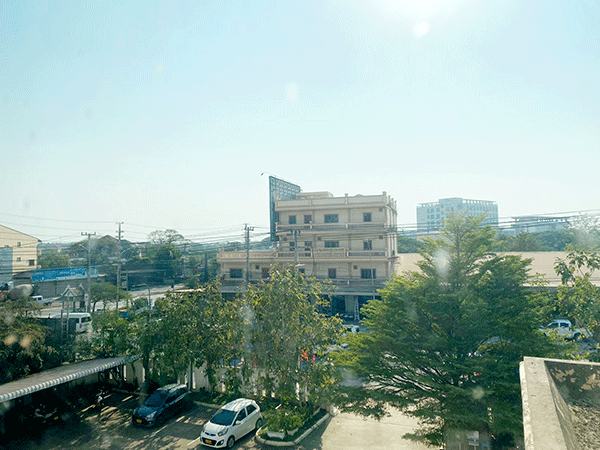Poor air quality raises health concerns
Air quality in several areas of Laos has deteriorated, with PM2.5 levels reaching thresholds that pose health risks, according to figures released by the Natural Resources and Environment Research Institute on February 3.
 |
| Air pollution in some areas of Vientiane has risen to unhealthy levels for the public. |
The highest PM2.5 concentration was recorded at 146.5 micrograms per cubic metre in Samakhixay district, Attapeu province, with an Air Quality Index (AQI) of 197, classified as unhealthy and potentially harmful.
PM2.5 refers to fine particulate matter measuring 2.5 micrometres or smaller, which can penetrate deep into the lungs and bloodstream, causing both short-term and long-term health issues.
Air quality is measured using the AQI, which categorises pollution levels as follows: 0-50 (good), 51-100 (moderate), 101-150 (unhealthy for sensitive groups), 151-200 (unhealthy), 201-300 (very unhealthy), and above 300 (hazardous)
Other areas where air quality was recorded at unhealthy levels included Khongxedon district in Saravan province; Pakxan district in Borikhamxay province; Akard village in Vientiane; Xanakham district in Vientiane province; Sikhottabong district in Vientiane; and Saravan district in Saravan province. These areas recorded AQI levels ranging from 153 to 163.
Air quality in several other locations, including Thakhaek district in Khammuan province, Chao Anouvong Park in Vientiane, Paek district in Xieng Khuang province, Viengthong district in Borikhamxay province, Xayaboury district in Xayaboury province, and Bounneua district in Phongsaly province, recorded PM2.5 levels between 51.1 and 61.1 micrograms per cubic metre.
These levels are classified as unhealthy for sensitive groups, posing risks to children, the elderly, and people with pre-existing respiratory conditions.
People with asthma, any chronic lung disease or cardiovascular disease are also at risk of exacerbated symptoms, which could prove fatal. The Ministry of Health advises wearing a face mask at all times when outside to reduce inhalation of fine ash or dust.
Prolonged outdoor activities such as exercise should be avoided, while it is advisable to drink plenty of water and drinks with mineral salts. Anyone with abnormal respiratory symptoms is advised to see a doctor immediately.
Xamneua district in Huaphan province reported the best air quality, with PM2.5 levels at 25.1 micrograms per cubic metre and an AQI of 25, classified as very good.
The Haze Monitoring Division of the Natural Resources and Environment Research Institute notes that Laos experiences severe air pollution every year during the dry season. Especially from April to May, thick smog covers many parts of the country, mainly due to farmers burning fields to prepare for the next planting cycle.
During this period, high temperatures, low wind speeds, and high humidity trap PM2.5 particles, leading to significant air pollution.
The Ministry of Natural Resources and Environment estimates that 30 percent of PM2.5 pollution in Laos is caused by the burning of garbage, forests, and farmland. Other major sources include vehicle emissions in urban areas and industrial plants using unclean forms of energy.
By Times Reporters
(Latest Update February 4, 2025)
|


